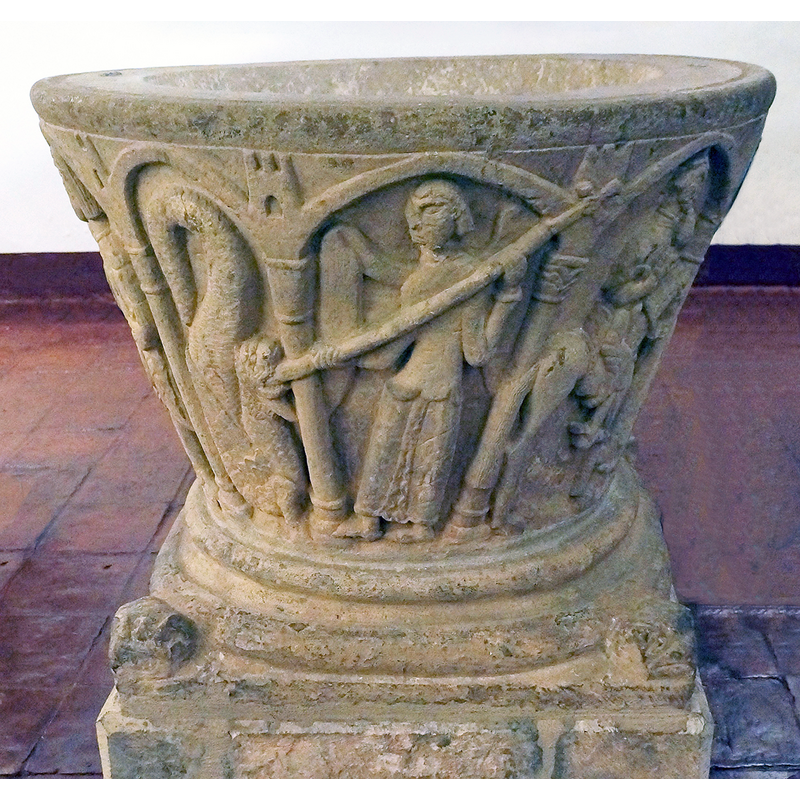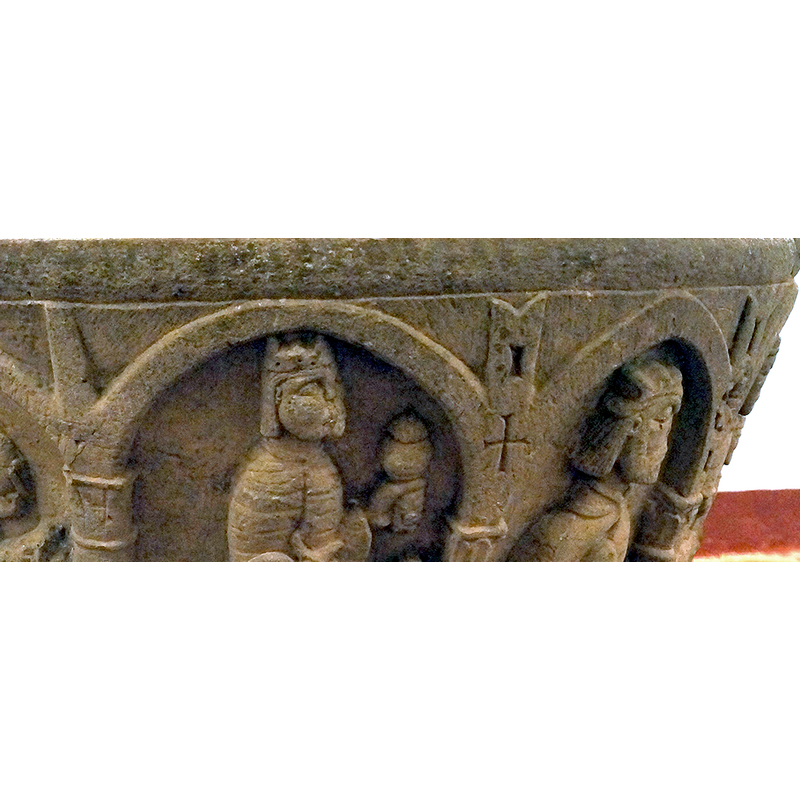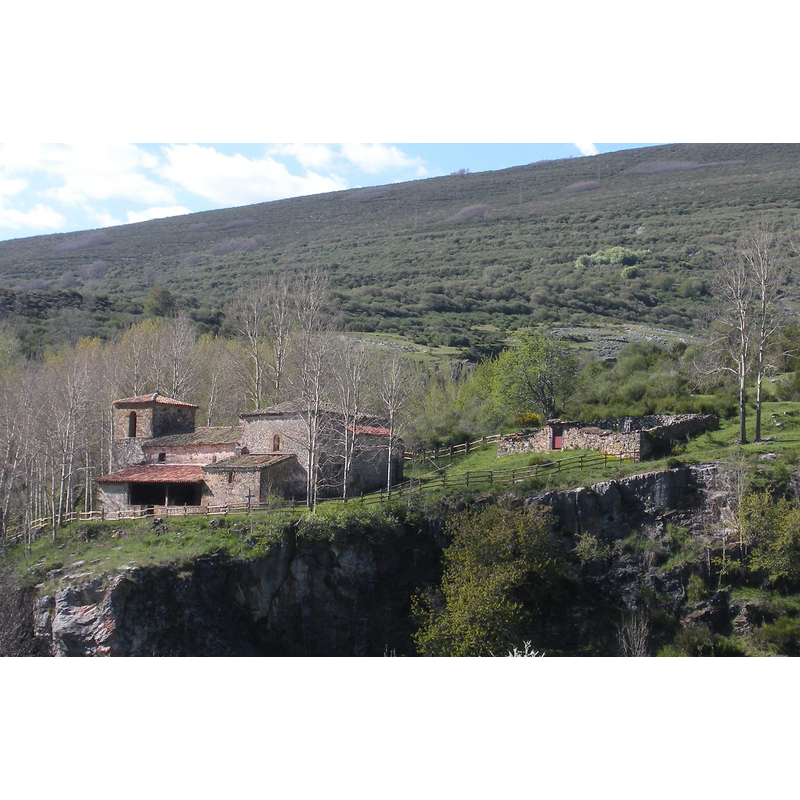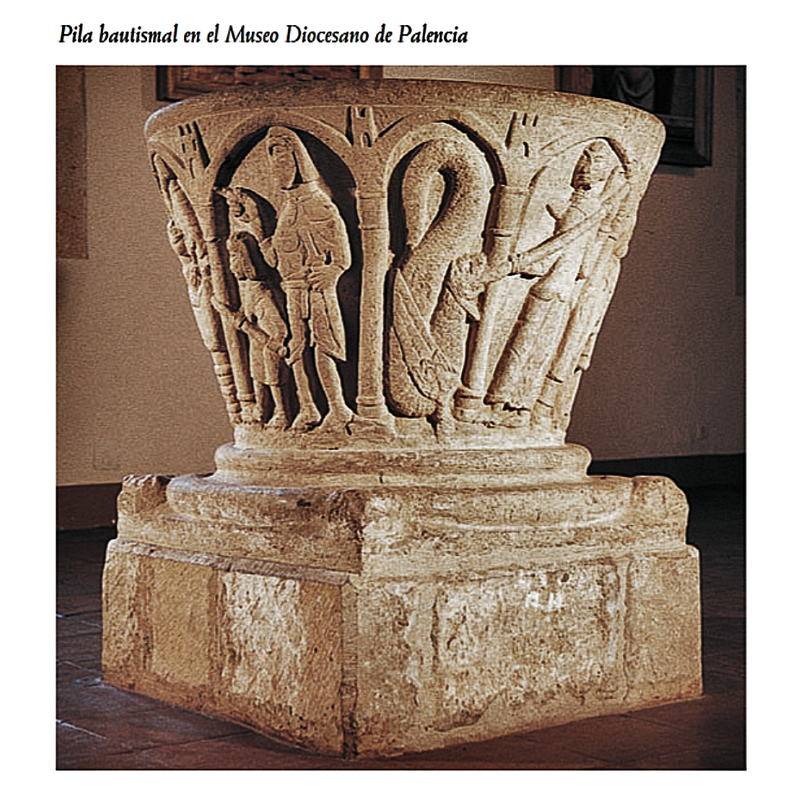Valcobero
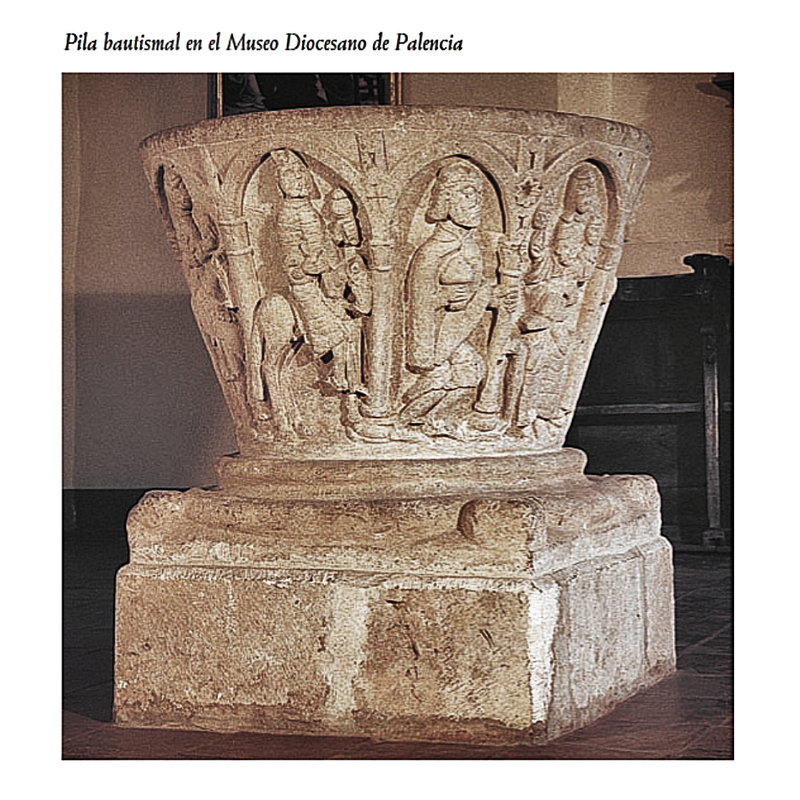
Image copyright © Fundación Santa María la Real, 2022
Standing permission received from the FSMLR
Results: 12 records
B01: New Testament - Childhood and youth of Christ - three Wise Men - adoration of the kings
Scene Description: the whole scene is spread over five arches, the Magi occupying three arches, one each, the first Magus kneels before the Madonna & Child; the other two behind, to the left, on horseback
Copyright Statement: Image copyright © Francisco José García Gómez, 2012
Image Source: digital photograph taken 11 July 2012 by Francisco José García Gómez
Copyright Instructions: Image and permission received (e-mail of 8 July 2015)
B01: New Testament - Childhood and youth of Christ - three Wise Men - adoration of the kings - one magus - Madonna and Child; Joseph
Scene Description: seen here are the kneeling Magus in the left arch, his right hand holding the gift for the newborn Child, his left hand holding the column of the arch; notice the decorations between the spandrels of the arcade; the arcade to the right, only partially visible, is occupied by Joseph, his body appears to be turned partly away from the event
Copyright Statement: Image copyright © Miguel Angel García Guinea, 1998
Image Source: B&W photograph in García Guinea (1998: 362)
Copyright Instructions: PERMISSION NOT AVAILABLE -- IMAGE NOT FOR PUBLIC USE
B02: sacrament - baptism - adult baptism [or martyrdom of a cleric]
Scene Description: the scene is spread over two arches; in the left arch are an adult human inside a decorated font, while a cleric (?) stands over and pours water (?) on the head of the baptizand from a container; in the next arch to the right are a short male, probably an accolite, carrying a candle (?), and an adult male, to the right, pointing to the baptismal scene in the previous arch with the index finger of his right hand [NB: this scene is interpreted as the martyrdom of St Lawrence in Bilbao (1996), or simply the martyrdom of a tonsured ecclesiastic in Ruiz Maldonado [cf. FontNotes]
Copyright Statement: Image copyright © Francisco José García Gómez, 2012
Image Source: digital photograph taken 11 July 2012 by Francisco José García Gómez
Copyright Instructions: Image and permission received (e-mail of 8 July 2015)
B03: angel - archangel - St. Michael and dragon
animal - mammal - lion - head - 4
Scene Description: very damaged now; the one on the left here is the least damaged of the four;
Copyright Statement: Image copyright © Francisco José García Gómez, 2012
Image Source: digital photograph taken 11 July 2012 by Francisco José García Gómez
Copyright Instructions: Image and permission received (e-mail of 8 July 2015)
design element - architectural - arcade - round arches - columns with capitals and bases - 9
design element - architectural - building - detail
Scene Description: some of the elements are simple crenellated towers, others, like two of them here (centre and right) are window-like; one, seen here on the left is... what?
Copyright Statement: Image copyright © Francisco José García Gómez, 2012
Image Source: detail of a digital photograph taken 11 July 2012 by Francisco José García Gómez
Copyright Instructions: Image and permission received (e-mail of 8 July 2015)
design element - motifs - roll moulding - 2
symbol - cross and flower
Scene Description: located below two of the spandrels of the arcade, only in the Adoration scene
Copyright Statement: Image copyright © Francisco José García Gómez, 2012
Image Source: detail of a digital photograph taken 11 July 2012 by Francisco José García Gómez
Copyright Instructions: Image and permission received (e-mail of 8 July 2015)
view of church exterior in context
Scene Description: the original church and its surrounding area -- Source caption: " Iglesia y cementerio de la localidad de Valcobero, en la provincia de Palencia (España)"
Copyright Statement: Image copyright © Goldorak, 2010
Image Source: digital photograph taken 22 May 2010 by Goldorak [https://commons.wikimedia.org/wiki/File:Iglesia_y_cementerio_de_Valcobero.JPG] [accessed 3 August 2015]
Copyright Instructions: GFDL / CC-BY-SA-3.0
view of font
INFORMATION
FontID: 02152VAL
Object Type: Baptismal Font1
Museum and Inventory Number: Museo Diocesano de Palencia (Palencia, Spain)
Church/Chapel: [orig. from the Iglesia Parroquial de San Lorenzo, Valcobero [now at the Museo Diocesano de Palencia]
Church Patron Saints: St. Lawrence [aka Laurence]
Church Location: 34886 Valcobero, Velilla del Río Carrión, Palencia, Spain
Country Name: Spain
Location: Palencia, Castilla y León
Directions to Site: Located in the municipality of, and 8 km from Velilla del Río Carrión [NB: the hamlet was uninhabited beteen 1970 and 2009]
Ecclesiastic Region: Diócesis de Palencia
Historical Region: Parque Natural de las Fuentes Carrionas y Fuente Cobre-Montaña Palentina
Font Location in Church: [see museum information]
Century and Period: 12th - 13th century, Late Romanesque
Workshop/Group/Artisan: Workshop of the Master of Cabestany? Master of San Isidoro?
Cognate Fonts: fonts of somewhat similar design at Cantoral de la Peña, Rabanal de las Llantas, Renedo de Valdavia and Respenda de Aguilar, all in the same region
Credit and Acknowledgements: We are gratefult to Francisco José García Gómez for his photographs of this font. We are also grateful to the Fundación Santa María la Real [www.romanicodigital.com] for their permission to reproduce content from the Enciclopedia del románico
Font Notes:
Click to view
Listed in the Catálogo Monumental... (1930-1946). Described and illustrated in Sancho Campo (1971) who dates it to the end of the 11th century and attributes it to the 'maestro de San Isidoro'. Described and illustrated in García Guinea (1990), and (1998). In Ruiz Maldonado ([s.d.]) and in Bilbao (1996) as a baptismal font of the Romanesque period. Described and illustrated in the Enciclopedia del románico en Castilla y León (2002-): "de esta iglesia procede una de las pilas románicas más interesantes de la provincia, en la actualidad conservada en el Museo Diocesano de Palencia. Consta de copa troncocónica y basa formada por una escocia y dos toros, el inferior con cabezas zoomorfas a modo de lengüetas. Se decora con diez arquillos ligeramente apuntados sobre columnas con capiteles esquemáticos y fustes lisos. Esta arquería abarca todo el perímetro de la pieza. Bajo sus arcos se localiza el tema de la Epifanía, una escena alusiva a la purificación y San Miguel alanceando al dragón. Vemos claramente el sentido procesional de los reyes a caballo y, muy especialmente, la figura del que en postura de adoración inicia la genuflexión sujetándose al fuste de la columna e intentando establecer algún vínculo con la Virgen. Ésta permanece ajena, hierática y con mirada frontal. Lo mismo ocurre con la figura de San José –apoyado sobre el bastón en forma de “T”– de la que emana cierta sensación de aislamiento. La Virgen, que aparece sedente, entronizada y mayestática reposa sobre una silla baja con cuerpos y cabezas de águila, lleva al Niño sobre sus rodillas, mientras que con su mano derecha sujeta una especie de piña. De acuerdo con los principios de la estética románica, no existe ningún tipo de relación entre las figuras de la Madre y el Hijo, aisladas entre sí a pesar de la relación que subyace entre ambas. A continuación se desarrolla una escena de bautismo por inmersión en la que aparece un personaje con tonsura dentro de una pila y otro con una especie de copa que se dispone a bautizarle. Bajo el arco siguiente figuran dos personajes, uno con espada envainada que señala con el dedo la escena anterior y otro más pequeño que porta un objeto alargado, posiblemente un cirio. Nos parece cuanto menos arriesgada la opinión de Garbiñe Bilbao para quien se trataría de una versión “única y excepcional” del martirio de san Lorenzo, en la que el artista románico transforma una escena de tormento en una de bautismo, expresando así lo que dicha autora denomina “bautismo de sangre”. Finaliza el programa iconográfico con la representación de San Miguel luchando con el dragón, en clara alusión al combate del Bien contra el Mal. En general, las figuras están tratadas con una gran sencillez y esquematismo, demostrando gran inexpresividad en el tratamiento de los rostros. En la pila bautismal aparecen otros elementos destinados a animar la rigidez general que envuelve el conjunto: cruces, círculos, rosetas inscritas en el interior de círculos, etc., en los espacios existentes entre los arcos, recordando la cenefa que corre sobre la arquería de la pila de Renedo de Valdavia. En las enjutas de los arcos aparecen simples torres almenadas, quizá reminiscencia de la Jerusalén Celeste o puro marco arquitectónico. Su cronología oscila entre los años finales del siglo XII e inicios del XIII. Para García Guinea existe un gran parecido con la pila de Renedo, no sólo en cuanto a la técnica del relieve, sino también respecto al esquema compositivo a base de arcos y en la representación de los Reyes Magos. Las similitudes estilísticas más certeras se establecen respecto a las pilas de Cantoral de la Peña y Rebanal de las Llantas, situadas en un entorno geográfico relativamente cercanno." The basin sides are divided into nine arches containing: a scene of the Adoration of the Magi, which shows Mary sitting on a throne adorned with eagle heads, her right hand holding a pine cone; the infant Jesus, crowned, sits on her lap, holding a book in his left hand while the right is raised in benediction; to his left is Joseph, bearded, wearing a conical hat and leaning on a staff; on the right of Mary are the three Magi, the first on his knees, the other two still on horseback, the first two bearded, the last looking quite different from the first two; in the next scene, St. Michael (or St. George?) fights the dragon; the next scene shows the following: inside a large mounted baptismal font is an adult male, hands and feet together, head visible; behind the font is another male figure "officiating"?; in the next arch two other male figures. Bilbao [cf. supra] argues that this is a rendition [creative?] of the martyrdom of St. Lawrence [parboiled instead of grilled?]; Sancho Campo (2002) describes this particular scene as being related to the purification ["escena alusiva a la purificación"] [NB: in this entry the author does not give the dating suggested in his previous work -- cf. supra]]. The entry in the Enciclopedia del románico en Castilla y León (2002-) rejects the 'risky' identification in Bilbao ["nos parece cuanto menos arriesgada la opinión de Garbiñe Bilbao para quien se trataría de una versión 'única y excepcional' del martirio de san Lorenzo"], and describes it as a baptismal scene. Ruiz Maldonado [Dialnet_2486765PDF] identifies the scene as the matyrdom of an unidentified tonsured eccleasiastic over two adjacent arches, and rejects the identification of they martyr as St. Lawrence or St. Vincent as lacking evidence of identification. HST comments: "So, good points. But this is still too odd a composition. The first visual recognition is that this is a baptismal font. Second the figure in the water is an adult. His hands are together as if in prayer, but they are bound – the rope around his wrists is being held by the person standing behind the font (he is not stabbing him). The b/w image in the article shows this. The object in his right hand is not necessarily a weapon – it could be a vessel, containing water. See attached carving at St. Denis. True, the diminutive person holding a cane attached to the font, is odd – the cane is hooked and pierces the font, you can see the top of the hook inside the vessel….plugging a hole? Holding the person down? Threatening the person? What were Spaniards up to then? The tall male figure holds ‘something’ in his raised hand – a scroll?….his left hand rests on the scabbard…forced conversion, baptism of prisoner? The martyrdom of St. Lawrence and St. Vicent are not portrayed this way…" The spandrels of the arcade have a number of symbols: cross, flower, tower, etc. The round-to-square lower base begins with a torus-scotia-torus sequence, with animal heads at the four angles of the lower moulding, and continues dow on a set of blocks that form a quadrangular lower base. Noted and illustrated in Martín Jiménez (2008). Noted and illustrated in the Sociedad Mercantil Estatal para la Gestión de la Innovación y las Tecnologías Turísticas, S.A.M.P. (SEGITTUR) [http://www.spainisculture.com/fr/obras_de_excelencia/museo_diocesano_palencia/pila_bautismal_valcobero.html] [accessed 29 September 2022]
COORDINATES
Church Latitude & Longitude DMS: 42° 51' 27.68" N, 4° 47' 1.66" W
UTM: 30T 354346 4747335
MEDIUM AND MEASUREMENTS
Material: stone, limestone
Number of Pieces: two
Font Shape: bucket-shaped (mounted)
Basin Interior Shape: round
Basin Exterior Shape: round
Diameter (includes rim): 103 cm*
Font Height (less Plinth): 82 cm* / 80 cm** / 81 cm***
Notes on Measurements: * Bilbao (1996: 304) and *Sancho Campo (1971, v. II: pl. 4 caption) / ** Sancho Campo (2002: 110) / *** www.españaescultura.es
LID INFORMATION
Notes: an iron staple from the original cover is still fastened to the upper rim
REFERENCES
Bilbao López, Garbiñe, Iconografía de las pilas bautismales del románico castellano: Burgos y Palencia, Burgos: Editorial La Olmeda, S.L., 1996
Fundación Santa María la Real, Enciclopedia del románico en Castilla y León, Aguilar de Campoo: Fundación Santa María la Real, Centro de Estudios del Románico, 2002-
García Guinea, Miguel Angel, El Románico en Palencia, Palencia: Excma. Diputación de Palencia, 1990
García Guinea, Miguel Angel, Románico en Palencia: guía, Palencia: Excma. Diputación de Palencia, Dpto. de Cultura, 1998
Martín Jiménez, Carlos A., Las mejores rutas por el románico de Palencia, Trobajo del Camino, León: EDILESA, 2008
Navarro García, Rafael, Catálogo monumental de la provincia de Palencia, Palencia: Obispado de Palencia, Comisión Diocesana de Arte / Imprenta Provincial, 1930-1946
Ruiz Maldonado, Margarita, "La pila bautismal de Valcovero (Palencia)", 60, Publicaciones de la Institución "Tello de Meneses" (CSIC), 1989, pp. 455-462; p. 453-462
Sancho Campo, Angel, "Arqueología de los siglos románicos en el ámbito de la actual provincia de Palencia", Palencia en los siglos del románico, Aguilar de Campoo: Fundación Santa María la Real - C.E.R., 2002
Sancho Campo, Angel, Arte sacro en Palencia, Palencia: Obispado de Palencia, Comisión Diocesana de Arte, 1971
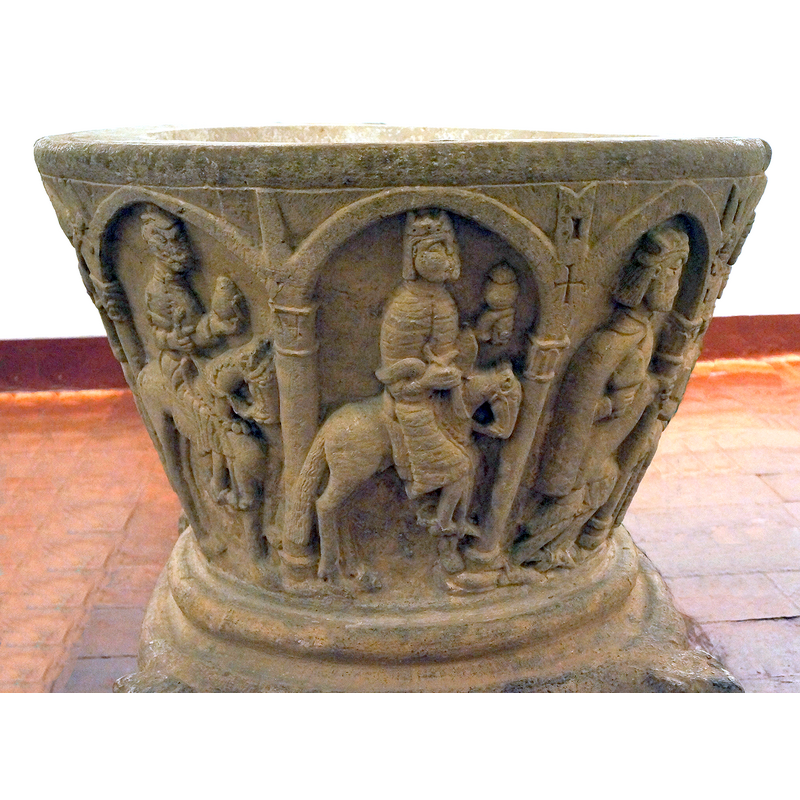

![the scene is spread over two arches; in the left arch are an adult human inside a decorated font, while a cleric (?) stands over and pours water (?) on the head of the baptizand from a container; in the next arch to the right are a short male, probably an accolite, carrying a candle (?), and an adult male, to the right, pointing to the baptismal scene in the previous arch with the index finger of his right hand [NB: this scene is interpreted as the martyrdom of St Lawrence in Bilbao (1996), or simply the martyrdom of a tonsured ecclesiastic in Ruiz Maldonado [cf. FontNotes]](/static-50478a99ec6f36a15d6234548c59f63da52304e5/compressed/1150803003_compressed.png)
